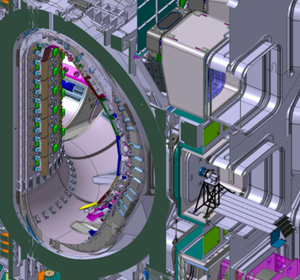Engineering Design and Digital Twin of the First Wall of a Tokamak Fusion Reactor
FA1 simulates the synthetic signal of an IR camera in nuclear fusion reactors. The workflow comprises three simulations: plasma power deposition to solid wall (field line tracing), temperature response (finite volume method) and optical simulation (ray tracing) to assess the light intensity at each camera pixel.
Do you want to request support from EXCELLERAT staff or consulting on this Use Cases?
*Registration is required to send inquiries.
Introduction
FA1 is dedicated to the high-fidelity numerical simulation of plasma power deposition to reactor wall (defined as triangular surface in 3D space) due to particles conducted along magnetic field lines via field line tracing algorithms. Once heat flux on the wall is obtained it is mapped to 3D tetrahedral model and heat equation is then solved via Finite Volume Method to asses temperature response of the wall. Final step is to take into account the reflection model of the first wall and radiation of the first wall due to temperature, as well as radiation from the plasma. Optical simulation is performed by randomly projecting large bundle of ray from camera pixels and check for intersection with plasma and first wall. Parameters of each ray are then calculated based on what they hit, averaged and the light intensity on the pixel is then given. The final goal of FA1 is designed to evaluate performance and scalability on current and upcoming HPC systems through OpenMPI and OpenMP parallelisation and inclusion of hardware accelerators such as GPUs.
Nuclear fusion is considered to be a promising renewable energy source. It offers localized and dispatchable energy source with high energy densities. Magnetically confined nuclear devices are considered to be the most efficient in terms of harnessing nuclear fusion energy, making it a suitable candidate for filling the energy needs of the future in case of successful implementation. Understanding the behaviour of plasma through diagnostic systems is important for the successful design of such devices. Fully integrated simulation from plasma thermal loading to synthetic signal of diagnostic systems will be conducted with advanced high-performance computing on leading-edge HPC architectures to predict the operation and behaviour of plasma.
The Challenge
Plasma power deposition to the first walls of magnetically confined devices poses fundamental challenges in terms of overheating the reactor and potentially damaging its key components. The key technology here is advanced diagnostic systems which monitor the plasma. This further application will attempt to simulate the process from plasma power deposition to signal capture by diagnostic systems.
Aim
The further application aims to prepare digital tools to obtain synthetic signals on IR cameras, taking into account the properties of plasma, IR camera and geometry of the first wall. The synthetic signals will act as a digital twin and will be compared to experimental images in already existing devices to adapt and prepare for ITER operation.
Development
Further application workflow consists of three main sub-simulations:
· Plasma power deposition: field line tracing algorithms are used to assess heat load to the first wall of a nuclear device, resulting in heat fluxes on the first wall surface. This will be achieved with ITER/UL in-house code L2G.
· Thermal load of the first wall: Heat fluxes are mapped to the 3D structure of the wall, resulting in boundary conditions for the thermal model to obtain temperature distribution on the first wall surface. This will be achieved using a customized heat transfer solver based on the OpenFOAM kernel.
· Optical simulation of IR camera: Temperatures from thermal loading will be used in optical simulations to assess reflectivity and radiation from first wall surfaces, resulting in a synthetic IR camera signal. The ray-tracing algorithms are used for this specific task. Further application aims to benefit from the Raysect code package, specifically designed for the simulation of physical processes in magnetically confined nuclear devices.
Benefits
Synthetic signal, representing a digital twin of the plasma and diagnostic processes will provide an insight into plasma behaviour, thermal loading and IR camera response. As such, it will provide information to the operators of magnetically confined nuclear devices to assess the behaviour of the plasma and make correct decisions for operating the device.


